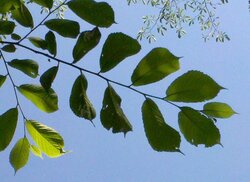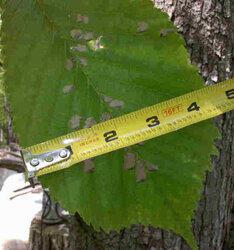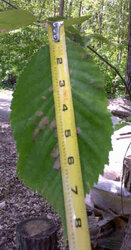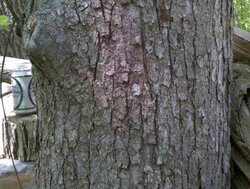I've got a species of tree that I can't identify. I'm in SE Minnesota, on 10 acres with plenty of the following trees (which I CAN identify): White Oak, Northern Red Oak, Burr Oak, Sugar Maple, Bitternut Hickory, Butternut, Eastern Hophornbeam (Ironwood), Hackberry, Black Cherry, and Aspen. based on the following leaf and bark photos, can anyone identify this tree. I've gone through two different tree ID books and can't seem to find anything that matches this leaf.
Tree ID help, please.
- Thread starter hkillam
- Start date
-
Active since 1995, Hearth.com is THE place on the internet for free information and advice about wood stoves, pellet stoves and other energy saving equipment.
We strive to provide opinions, articles, discussions and history related to Hearth Products and in a more general sense, energy issues.
We promote the EFFICIENT, RESPONSIBLE, CLEAN and SAFE use of all fuels, whether renewable or fossil.
You are using an out of date browser. It may not display this or other websites correctly.
You should upgrade or use an alternative browser.
You should upgrade or use an alternative browser.
- Status
- Not open for further replies.
indiana4spartans
Member
thewoodlands
Minister of Fire
Yeah, I'm supposed to have basswood on the property, but the leaf pattern just didn't seem to match what I saw in the books. I didn't mention basswood in the first post 'cause I didn't want to "lead the jury".
I'll be interested to see what other members think.
I'll be interested to see what other members think.
indiana4spartans
Member
I first looked at this post on my iPhone. Now that I've seen the pictures on my desktop - I stand by my first post - BASSWOOD.
firefighterjake
Minister of Fire
Maybe the basswood out that away is different from the American Basswood found in Maine . . . because the basswood here is quite different . . . the leaves are large and kind of heart-shaped . . . and don't grow in the arrangement shown . . . they tend to grow singularly vs. in a compound arrangement.
That said . . . I don't recognize the tree species. My first thought was some type of ash . . . but the leaves are wrong . . . wrong shape and the arrangement on the leaf stalk is wrong . . . they're alternating vs. ash which has the leaf arranged directly across from each other in a symetrical fashion.
That said . . . I don't recognize the tree species. My first thought was some type of ash . . . but the leaves are wrong . . . wrong shape and the arrangement on the leaf stalk is wrong . . . they're alternating vs. ash which has the leaf arranged directly across from each other in a symetrical fashion.
firefighterjake
Minister of Fire
Here's a link to Basswood.
http://www.umext.maine.edu/mainetreeclub/FactSheets/odd-year-htm/AmericanBasswood.htm
http://www.umext.maine.edu/mainetreeclub/FactSheets/odd-year-htm/AmericanBasswood.htm
smokinj
Minister of Fire
Jake, you stated perfectly the characteristics that have caused me to wonder if it really is basswood. "...different from the American Basswood found in Maine . . . because the basswood here is quite different . . . the leaves are large and kind of heart-shaped . . . and don’t grow in the arrangement shown . . . they tend to grow singularly vs. in a compound arrangement"
These leaves aren't heartshaped, they taper at both ends. The also measure larger then the typical basswood leaf size stated in the books I'm using for tree ID.
I thought the leaves were simple, compound alternate in structure. Maybe I've misread that and they are just simple alternate. In that case, maybe it's Slippery Elm. Leaf size and shape is correct, plus the leaves have some forked veins near the margins (though basswood has that too).
Anyone familiar enough with Slippery Elm to either confirm or deny that as an ID?
These leaves aren't heartshaped, they taper at both ends. The also measure larger then the typical basswood leaf size stated in the books I'm using for tree ID.
I thought the leaves were simple, compound alternate in structure. Maybe I've misread that and they are just simple alternate. In that case, maybe it's Slippery Elm. Leaf size and shape is correct, plus the leaves have some forked veins near the margins (though basswood has that too).
Anyone familiar enough with Slippery Elm to either confirm or deny that as an ID?
smokinj
Minister of Fire
New Garn Gasser said:Jake, you stated perfectly the characteristics that have caused me to wonder if it really is basswood. "...different from the American Basswood found in Maine . . . because the basswood here is quite different . . . the leaves are large and kind of heart-shaped . . . and don’t grow in the arrangement shown . . . they tend to grow singularly vs. in a compound arrangement"
These leaves aren't heartshaped, they taper at both ends. The also measure larger then the typical basswood leaf size stated in the books I'm using for tree ID.
I thought the leaves were simple, compound alternate in structure. Maybe I've misread that and they are just simple alternate. In that case, maybe it's Slippery Elm. Leaf size and shape is correct, plus the leaves have some forked veins near the margins (though basswood has that too).
Anyone familiar enough with Slippery Elm to either confirm or deny that as an ID?
elm
Wood Duck
Minister of Fire
I think it is Basswood, and it is possible that the Basswood in the midwest differ enough from the ones in Maine to make FFJ think your tree isn't basswood. My guide says basswoods are a "small but complex genus" but goes on to mention the alternate, simple leaves (shown in your picture), heart shaped (yours are in the general neighborhood of heart-shaped), and toothed leaves 5 to 10 inches long. I don't know of many trees with toothed leaves of that shape that are as large as the ones on your tree. The bark also looks reasonably similar to Basswoods i have seen (although I don't see many). if it is basswood, you should see the distinctive fruit, which have large wings sort of like maple seeds, and you should see flowers soon.
ramonbow
Member
The leaves do not look like the basswood we have in the yard or the wild ones in the woods and I am pretty close to SE MN. They are more heart shaped and do not tend to taper near the leaf stalk. The bark does look similar to basswood. The leaves look like elm but are bigger. Were the leaves taken from a water sprout by any chance?. Sometimes leaves from water sprouts or shoots at the base of the trunk are abnormally large.
JustWood
Minister of Fire
Ramon, I didn't know this: "...Sometimes leaves from water sprouts or shoots at the base of the trunk are abnormally large"
I DID take them from low on the tree. Ugh, never occurred to me that that would matter. I guess I'll have to pull out the ladder tomorrow and make sure I'm getting a leaf from up higher. I'll make sure it matches other leaves higher up the tree. I'll post what I get. Thanks, everyone, for helping me try to figure this out!
I DID take them from low on the tree. Ugh, never occurred to me that that would matter. I guess I'll have to pull out the ladder tomorrow and make sure I'm getting a leaf from up higher. I'll make sure it matches other leaves higher up the tree. I'll post what I get. Thanks, everyone, for helping me try to figure this out!
Wood Duck
Minister of Fire
Basswood should soon have some flowers or seed pods with big leafy wings on them. The seed pods are easy to see from a distance and distinctive.
thewoodlands
Minister of Fire
I have to go with slippery elm. VT has a great site.
http://www.cnr.vt.edu/dendro/dendrology/syllabus/factsheet.cfm?ID=42
You can use this second link for future searches. Once the site comes up use the tool feature then your off and searching.
http://www.cnr.vt.edu/dendro/dendrology/main.htm
Zap
http://www.cnr.vt.edu/dendro/dendrology/syllabus/factsheet.cfm?ID=42
You can use this second link for future searches. Once the site comes up use the tool feature then your off and searching.
http://www.cnr.vt.edu/dendro/dendrology/main.htm
Zap
Sorghum
Member
FLINT
Minister of Fire
Hey guys,
that tree is definitely definitely elm - not sure whether slippery or american - but its certainly elm.
it is also definitely definitely NOT basswood. basswood leaves are more heartshaped with simple teeth along the edge. Elm has a doubly serrate leaf edge - which means that the teeth are serrated.
that tree is definitely definitely elm - not sure whether slippery or american - but its certainly elm.
it is also definitely definitely NOT basswood. basswood leaves are more heartshaped with simple teeth along the edge. Elm has a doubly serrate leaf edge - which means that the teeth are serrated.
the_dude
Feeling the Heat
I took the leaves in to a local landscape supply business - one that does quite a bit of business in trees, from saplings to 20+ footers. He confirmed that it was Elm, no question. He wasn't certain if it was Slippery Elm or some other Elm species. He told me that we do have Slippery Elm in the county, but that it isn't real common.
Thanks to everyone for your responses, comments, and helpful links!
Thanks to everyone for your responses, comments, and helpful links!
RobC
Minister of Fire
Basswood I've usually called "linden" or and the leaves aren't quite right. Even on bigger trees the bark is usually smother. But we already established this.
As to the variations in leaf size..... That is a reflection of how much light the leafs receive in relation to position on tree. For example lower leafs and especially inside canopy are bigger. This would concur with the sucker or water sprout post. Saplings that started growing on the forest floor usually have bigger leafs. It's not uncommon to see a maple leaf that is the size of your hand. It's natures way....
Rob
As to the variations in leaf size..... That is a reflection of how much light the leafs receive in relation to position on tree. For example lower leafs and especially inside canopy are bigger. This would concur with the sucker or water sprout post. Saplings that started growing on the forest floor usually have bigger leafs. It's not uncommon to see a maple leaf that is the size of your hand. It's natures way....
Rob
Wood Duck
Minister of Fire
I checked out a bunch of the Elms around here this weekend, and many of them do have leaves as large as the ones in the picture. The biggest leaves are on sprouts originating near the base of the tree, but some of the healthier upper branches seem to have some pretty large leaves, too. Elm leaves are sandpapery, very different from basswood.
- Status
- Not open for further replies.
Similar threads
- Replies
- 0
- Views
- 717
- Replies
- 27
- Views
- 7K
- Replies
- 13
- Views
- 2K





